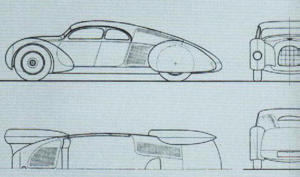 |
As of today, there are four Bugatti Veyron 16.4 Grand Sport Vitesse roadsters in the world, the fastest open-topped cars ever built, each valued at a minimum of $2.4 million and capable of hitting 255 mph. Driving one feels like the ultimate cheat code in the video game of life; maximum power, near invincibility and all the coins. It's also a peek inside the hidden kingdom of Bugatti owners, where $20,000 tire changes seem logical.
First, some
genealogy: The Grand Sport Vitesse is the final evolution of the Bugatti
Veyron launched in 2005. Those cars had 1,001 horsepower from their
16-cylinder, quad-turbocharged engines; the Grand Sport Vitesse makes an
even 1,200 hp, combined with a sleeker body, suspension changes and a
removable roof. After building about 350 Veyrons, Bugatti has vowed to
build about 100 more.
Parked outside my hotel, the
Vitesse sits as if someone pulled to the valet counter in a space
shuttle. Awaiting me for my ride was Andy Wallace, a former 24 Hours of
LeMans winner who's now Bugatti's on-call driver, showing owners and
potential buyers how to get the car to 250 mph and back to zero without
dying. It's like being an astronaut whose rocket goes forward instead of
up.
more after the cut...
Wallace spent several minutes showing me how easy the Vitesse was around suburban Connecticut. He might as well been narrating "50 Shades of Gray" in Esperanto for as much heed as I could muster, because nothing is normal when riding in a vehicle as orange as a Sunkist bottle with more horsepower than any NASCAR, Formula 1 or LeMans car.
 A
few notes did make it through: The Veyron rides low, requiring some
assessment of driveways and curbs. It's a taut ride at everyday speeds,
but rarely unpleasant. There are no touch screens, no video displays and
perhaps most shockingly, no cupholders — because with 1.4 g's of
lateral acceleration, a Starbucks venti would turn into a hot liquid
grenade.
A
few notes did make it through: The Veyron rides low, requiring some
assessment of driveways and curbs. It's a taut ride at everyday speeds,
but rarely unpleasant. There are no touch screens, no video displays and
perhaps most shockingly, no cupholders — because with 1.4 g's of
lateral acceleration, a Starbucks venti would turn into a hot liquid
grenade.Your first surprise is the Vitesse's natural soundtrack. At low speeds, there's just this bass rumble from the 8-liter W-16 engine churning behind your shoulders. But when you blip the throttle, the four turbos spool up to force more air into the engine, then blow off excess pressure through their wastegates in a loud "whooooasssssh." It's as close as I will ever come to having a dragon snort on my neck.
Wallace did one launch of the Vitesse on an on-ramp. I can't say what speed we hit, because I couldn't turn my head to look at the speedometer from the passenger's seat. I can say that Bugatti's claim of 60 mph in 2.5 seconds feels like physical proof that Einstein was right about time slowing if you accelerate fast enough.
With that, Wallace gave me the reins to the dragon.
One of the great untold secrets about the Bugatti Veyron? It's a family car. Not in the sense that it could hold a stroller — it can barely fit a diaper bag in its front hatch — but that it exists only because of ancient familial pride.
Ettore Bugatti was one of the auto industry's great eccentric geniuses. Between World War I and II, Bugatti not only won more races than any other automaker until Ferrari in the '60s, but built some of the world's finest cars under his name for the royal and the wealthy. He was also given to piques that'd make Steve Jobs blush; when one customer showed up to the French factory in an Opel cab, Bugatti refused to sell him a car. When an electric company sent him a bill in a fashion he thought rude, Bugatti built his own power plant.
 Drawings of Porsche's proposed Type 52 luxury carWhile
Bugattis cars were triumphing on the track in the early 1930s, a German
engineer named Ferdinand Porsche was drafting plans for a new Grand
Prix race car, one powered by a massive supercharged V-16 engine. With
support from Hitler's German government, Porsche's Auto Union Type C
cars and Mercedes' competing entries began to outpace Bugatti, who had
no supporter to match.
Drawings of Porsche's proposed Type 52 luxury carWhile
Bugattis cars were triumphing on the track in the early 1930s, a German
engineer named Ferdinand Porsche was drafting plans for a new Grand
Prix race car, one powered by a massive supercharged V-16 engine. With
support from Hitler's German government, Porsche's Auto Union Type C
cars and Mercedes' competing entries began to outpace Bugatti, who had
no supporter to match.When Bugatti died in 1947, his firm collapsed. After one failed revival in the early 1990s, Volkswagen chairman Ferdinand Piech had VW buy the rights to the Bugatti name, a move that puzzled other executives. In his first meeting with VW engineers in 1999, Piech set the parameters for what the 21st-century Bugatti should do. It had to produce at least 1,000 hp. It had to reach 62 mph in less than three seconds. It had to surpass a top speed of 252 mph — the fastest speed ever hit at LeMans. And it had to do all of this while being capable of polite trips to the opera.
Ferdinand Porsche had plans to
build a luxury road car with his supercharged 16-cylinder world beater
that never came true. Seven decades later Piech — Ferdinand Porsche's
grandson — finished the job, with Bugatti's coat of arms.
from: autos.yahoo
No comments:
Post a Comment